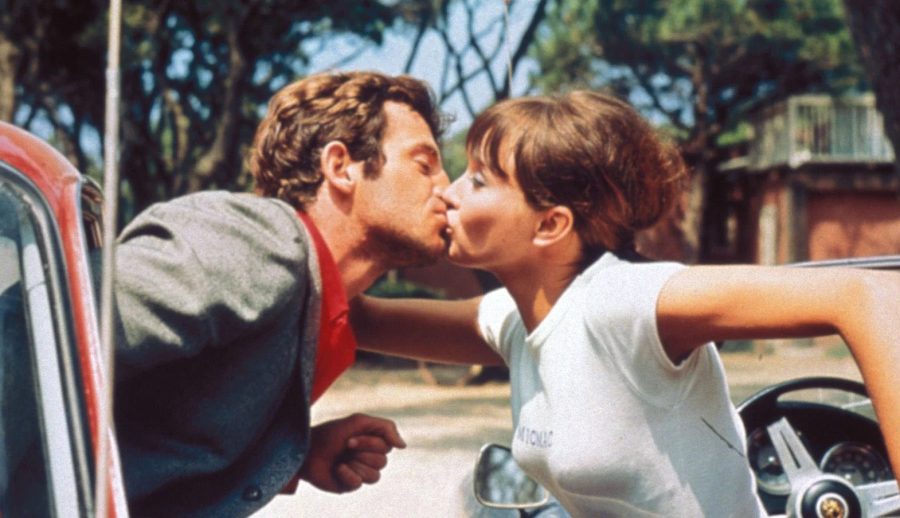“Pierrot Le Fou” and the Cinema of Godard
Jan 8, 2023
In this extensive essay about the 1965 film “Pierrot Le Fou” and its director Jean-Luc Godard, A&E Senior Staff Writer Matthew Risley attempts to capture and explain the romantic essence of the film, while also exploring Godard’s filmmaking philosophies and highlighting his expansive filmography and the impact it’s had on both Godard and himself.
In September of 2022, Jean-Luc Godard passed away. He was a fantastic director, a creative visionary, and a fanatic who devoted his entire life to film. In his early twenties, he was writing impassioned essays in “Cahiers du Cinema,” a French film magazine that would become the most influential of the twentieth century. His debut film “À bout de souffle” (Breathless) in 1960 stunned the world and forever changed cinema — Roger Ebert said of it, “No debut film since ‘Citizen Kane’” has been as influential. For Godard, the cinema was life. He directed over 40 films during his lifetime, with his final film “Le Livre d’image” (The Image Book) being released in 2018 when he was 88 years old.
I was introduced to Godard by chance. During high school, my French teacher recommended one of the first French New Wave films, “Les 400 Coups” (The 400 Blows) by Truffaut. I believed the film was fantastic and started researching the French New Wave. I stumbled upon “Pierrot le Fou” while on this search; the beautiful pastel stills drew me in immediately. Fittingly, I watched “Pierrot” on a first date, enamored by every frame. I was interested in film, but I had not yet delved into the vast library of cinema, and “Pierrot le Fou” was unlike anything I had seen before. Though I have watched many of Godard’s films, “Pierrot le Fou” remains my favorite and what I consider to be his peak of romanticism.
The film begins with Ferdinand (Jean-Paul Belmondo) reading a passage about Spanish painter Diego Velázquez to his daughter. Before we are even introduced to who this man is, Godard has begun including passages recognizing the artistic achievements of those he admires. Every time I watch a film by Godard, I feel as though I have not yet received the education that is necessary to fully understand what Godard admires; I come away with an impassioned desire to learn about these artists. After finishing the passage, his wife complains that he has allowed their housekeeper to go to the cinema three times this week, to which he retorts, “Of course I did, they’re showing Johnny Guitar. Good for her education.” “Johnny Guitar,” a 1954 film by Nicholas Ray, was a favorite of Godard’s and the “Cahiers du Cinema” group of filmmakers. Godard’s absolute admiration of the cinema, and his vision of its ideal form, shine through in only the first few minutes of the film.
Ferdinand must accompany his wife to a party, which he has no desire to do. The scene is covered by differing colors while he hears drab and empty conversations. “My hair stayed light and soft all day thanks to Elnett Satin Spray” a woman flirts, while Ferdinand mopes about. Fed up by the dreary consumerism of the bourgeoisie, he returns home to find the babysitter, his ex-lover and the supposed niece of his friend Frank, Marriane (Anna Karina) asleep. He offers to drive her home.
They had been in love five and a half years ago; Marriane calls Ferdinand “Pierrot” (as I will for the remainder of this article) and he admonishes her. She discusses how in photos you know nothing about the individual photographed: was he a good man? Did he have a wife? A Mistress? Pierrot responds, “c’est la vie.” In an attempt to escape his uneventful life, he decides to run away with Marriane. This lighthearted, seemingly disjointed, and impulsive conversation invokes a desire to follow the characters on screen, to buck any responsibilities and run off.
Soon after, the film cuts to Pierrot and Marriane in a different apartment; a sparsely decorated place with guns and ammunition lining the walls. Rather than addressing this, Marriane launches into song and the pair argue whether or not they have agreed to love each other forever. Godard then begins a manner of storytelling he will repeat throughout the film: he cuts to still shots of paintings and scattered stills of the apartment while Pierrot and Marriane talk over the images. Marriane explains that she and her brother Fred knew people involved in the Algerian war, and the scene cuts to Pierrot walking past a dead man lying on the floor of the apartment. Frank returns to the apartment and the pair scheme to knock him out and then escape. The pair elope and must fill their Peugeot with gas. Though they have no money, they outwit and subsequently beat up the gas station attendants through comedic ploys.
While driving, Godard again flashes paintings and comics across the screen, while Marriane exclaims, “It was a love story!” Cutting back to the car, Pierrot looks into the rear-view mirror, and exclaims he sees “the face of a man about to drive over a cliff,” to which Marriane replies, after turning the mirror, “I see the face of the woman in love with a man about to drive over a cliff.” Pierrot turns and responds, “then let’s kiss.” I must include this entire section of dialogue because I believe it perfectly illustrates the love “Pierrot le Fou” displays. The film is the perfect love story; it shows love as one wishes it was. An overjoyed, youthful, and limitless adoration of another. After viewing this film, when one falls in love they see themselves as Pierrot, endlessly dazzled by another. A love that leads to crazy and irrational moments.
Pierrot and Marriane stop at a bar and order drinks, wondering how to pay for them. They tell stories to the patrons in hopes of a tip, Pierrot describing summer and how lovers long for the warm evening air. They feign a car accident to escape the grasp of the police and Marriane’s involvement, setting the car ablaze with a rifle. As they begin to walk, all Pierrot says is that travel broadens the mind.
The couple saunter through the countryside, crossing rivers, marching through fields and forests, and picking flowers. They steal a car and change clothes, Pierrot turns to the camera and exclaims all Marriane thinks about is fun. Pierrot drives the car straight into the sea, another absurd, passion-fuelled act. Marriane doesn’t complain; they walk until dusk and fall asleep on the shore. They make love and wake up covered by the sand.
Pierrot becomes obsessed with poetry, the pair laze around the shore while squatting in a small hut; “perfect happiness!” Pierot exclaims. However, the pair’s differences start eating away at their happiness, “you speak to me in words, and I look at you with feelings” Marriane complains. Pierrot speaks directly to the camera, expressing for Godard that this film is not about people’s lives, but only life itself.
The pair begin to reconcile and continue to prance through the countryside. “She makes me think of music,” Pierrot exclaims, “It’s a fine day my love, in dreams, in words, and in death.” Throughout these sequences, Godard paints the lovers with beautiful and welcoming pastels. Godard evokes a feeling similar to Shakespeare’s 138th Sonnet. One of youthful bliss, ignorant of the world, and utterly flattered by one another.
Finally, for one can only dream that bliss would last forever, the people Marriane was involved with — gun-runners of a sort — catch the pair and they are separated. Marriane is taken; Pierrot rushes to find her and discovers she has killed her captor but has disappeared. Other mobsters find him and torture him into confessing her potential whereabouts before freeing him. Dejected, Pierrot wanders onto train tracks and sits down, “what a terrible five in the afternoon” he laments, only to dash out of the way a second before the train barrels through.
Though I earlier claimed that this film was the perfect love story due to its seemingly unlimited joy delivered through the protagonists, I must correct myself. At this point Godard transitions to detailing the mistress of love, that terrible feeling of heartbreak. One is not complete without the other, the vibrant contrast between the two is what gives each such power.
Pierrot searches for Marriane in vain, finally settling down on the coast. She suddenly appears and convinces him to accompany her on a mission to help her brother Fred. Pierrot agrees, desperately scrambling to rekindle the relationship with Marriane. Along with Marriane and Fred’s accomplices, he double-crosses a deal and delivers the money to Marriane. We find that Fred is not Marriane’s brother, but another lover. Pierrot, unknowing of Marriane’s plan, romantically claims he will count to 137, and that by the time he finishes she will be back and they will elope for the last time.
Pierrot reaches 89; Marriane and Fred are shown embracing while Pierrot counts ever higher. He realizes something is wrong, rushes after her, and arrives seconds too late; she has embarked on a boat, the promises of a love lasting forever sailing with her. He hops aboard another boat to chase after Marriane and Fred, disembarking on an island before seeing them running together. He chases and in a rash shootout hits both Fred and Marriane.
She lies dying and asks Pierrot to forgive her. “My name’s Ferdinand. It’s too late” is all he mutters. He finds dynamite in the garage of the hideout, alongside a bucket of blue paint. Without any thought, he paints his face blue. Screaming, he runs outside and ties the dynamite around his head. He lights the fuse and, too late, realizes his idea of a glorious, romantic death is idiotic.
A massive explosion paints the skyline, the camera pans to the sea. The two lovers have reconnected. Eternity is theirs again.
Godard has described the indescribable feeling of love. Like all of his films, it is not about the characters, it is about life itself. All that one has felt is conveyed through these peoples’ lives. This film baffles the youth who has not yet experienced all that is on screen, but it makes the most wonderful sense to the lovestruck; the most terrible sense to the heartbroken. I cannot hope I have done this film justice in my depiction; I can only hope that I have done well enough to encourage others to experience it.
Though Godard is by no means unappreciated by those interested in film, his praise is often limited to his work during the French New Wave. “Pierrot le Fou” comes from this time period, yet he continued to create boundary-breaking films for decades afterward. For Godard, the emergence of digital cameras simply expanded the possibilities of cinema, he pushed each as far as he could. In 2014, at the age of 84, his film “Goodbye to Language” delved into the possibilities of using 3D to portray images unimaginable on a flat screen. His intention with this was, as it always was, not to entertain; it was to prod the medium further, to provoke each member of the audience to examine their relationship with it and with their loved ones. Although each of his films deserves to be watched and watched again, his substantial filmography is a barrier to many (I myself have not yet seen all of his films). Thus, I will attempt to provide a list of his most essential works and I wholeheartedly encourage anyone interested in film to explore his oeuvre.
From his time within the New Wave: “À bout de souffle” (Breathless, 1960), “Masculin féminin” (Masculine feminine, 1966), “Deux ou trois choses que je sais d’elle” (Two or Three Things I know About Her, 1967), and “Week-end” (1967). Godard famously asserted that “All you need to make a movie is a girl and a gun” which he undoubtedly proved in “À bout de souffle.” Chock-full of references to cinematic history, and an adoration for the Golden Age of Hollywood, Godard broke barriers of editing continuity with frequent jump cuts. A carefree, floating, and fast-paced film, “À bout de souffle” remains the most important, innovative, and influential debut film in the last 60 years.
Following this period, and picking up from the political ideas within “Week-end,” Godard formed the Dziga Vertov Group collective, predominantly with Jean-Pierre Gorin (a Professor Emeritus at UCSD!) alongside other filmmakers. From the collective: “Le Vent d’est” (Wind from the East). After the dissolution of the collective, Godard and Gorin collaborated again for “Tout va bien” (All’s Well). Throughout these polemical films, Godard and Gorin’s Marxist viewpoints are thrust forward in an incensed manner, becoming the focus of each film.
Following this group’s dissolution, Godard began to re-examine his relationship with the medium, alongside his past work. In “Ici et Ailleurs” (Here and Elsewhere, 1976) he examines and critiques his own work within the Dziga Vertov collective, while demonstrating the vast differences between the life of a French family and the life of Palestinian fedayeen fighters.
A few years later, Godard released “Sauve Qui Peut (la vie)” (Every Man for Himself, 1980), which he described as his second first film, marking a significant shift away from the polemical films he had been engaged with for a decade. Within this period one must watch: “Prénom Carmen” (First Name: Carmen, 1983), “Je vous salue, Marie” (Hail Mary, 1985), and “King Lear” (1987). “King Lear” remains one of Godard’s most outstanding achievements. His focus is not on a retelling of Shakespeare, but on examining the medium of film, and a need for cinema to reinvent itself; finally positing that he himself would be the one to do so. Surrounded by production disasters and thoroughly polarizing critics, “King Lear” is not only one of his most outlandish films but one I believe will be dissected and increasingly admired in the future.
After the turn of the century, Godard continued his experimentation with the medium. From this period: “Éloge de l’amour” (In Praise of Love, 2001), “Adieu au Langage” (Goodbye to Language, 2014), and “Le Livre d’image” (The Image Book, 2018).
Jean-Luc Godard posited that “Photography is Truth. The cinema is truth 24 times a second.” As one of the greatest artists to have worked within the past century he spent his entire life fighting to develop the art he so loved, the art that was the only constant in his long and tumultuous life. Nearly every film he has made has polarized critics, being at once praised as a new achievement in film and dismissed as self-indulgent and bizarre. After his lengthy career, it is difficult to imagine a cinema without a place for Godard. Though some polemics argue cinema is dead and that without Godard it looks bleaker than ever, this is not the case. Cinema will continue to thrive, filmmakers across the world are continuing to innovate and experiment. Godard brought more to the medium than any lover of cinema could have hoped for. In death, his creations will continue to be celebrated, just as they have in life. No, cinema will not die. Through his life of toil, his endless passion for this art form, Godard has assured us of that.
Image courtesy of Slant Magazine


















eva • Jan 11, 2023 at 11:49 am
I honestly don’t see why more people haven’t done this given that I work two shifts, two during the day and two during the evening. And I surely received a $29,000 check. Being able to work from ac64 home allows me to spend more time with my children, which is wonderful.
.
.
See this article for further details—————————————>>> WORK AT HOME